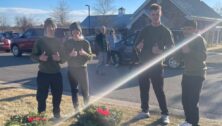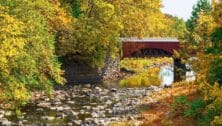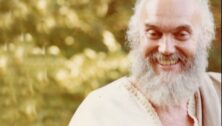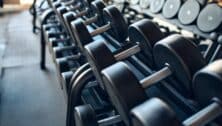Bucks County Community College’s Hicks Arts Center Unveils New Exhibit This Week

Bucks County Community College will soon host an art exhibit that features the work of several artists working with a singular concept.
The college’s Hicks Art Center Gallery is pleased to present a group exhibition of new and historic art works featuring U.S. and internationally based artists. “Code Number Safe [Un]Safe” will be on view from Jan. 18 through March 4.
The group exhibition will feature sculpture, painting, drawing, collage, assemblage, photography and video works by various artists. Miriam Carpenter, Paul W. Evans, Helen Rebekah Garber, Hand Drawn Map Association (KrisHarzinski), Daniel Healey, Edward Ellis Hughes (Courtesy of The Petrucci Family Foundation), Barbara Martin, Kathleen McSherry, Neal Pressley, Lorna Simpson (Courtesy of The Petrucci Family Foundation), and Steina and Woody Vasulka (Courtesy of Electronic Arts Intermix) will be some of the featured artists.
The premise of the exhibition “Code Number Safe [Un]Safe” is built around the concept of numbersand numeric systems holding values for safety and stability or on the contrary- impermanence and oppression. The cohort of artists participating in the exhibition use numbers and numeric identifiers to describe personal, process and historical narratives through sculpture, painting, collage, or visual diagrams/images that symbolize spaces for realized well-being or vessels of conflict.
Artistic expression is often codified solely as a right-brain endeavor. However, many artists utilize left- brain processes, organically, out of preference or necessity, by sourcing a multitude of numericsystems to augment right-brain creative activities; in artworks deploying painting, printmaking, photography, video, assemblage, and sculpture in the exhibition “Code Number Safe [Un]Safe.”
For example, Lorna Simpson’s photogravure and screen-print work, “Counting” employs various means of quantifying time, history, architecture, and the body(hair) with texts flanking three images while Barbara Martin’s expressionist paintings include repetitive marks or tallies to measure rhythm in dance. Enumeration for Paul W. Evans is made visible by tackling familial relationships through sibling birth order. In addition, Evans paints and collages numbers juxtaposed with plant shapes to question the proliferation and detrimental side effects of genetically modified organisms to humans and the environment.
Neal Pressley’s “No. 7” series of woodblock prints capture a historic building’s past identification before it was erased during the site’s development into a construction company’s Lancaster headquarters. An augmented reality video will illustrate where the “No. 7” was originally seen on the building prior to its transformation. Daniel Healey’s Letraset transfer drawings are shape forms the artist meticulously creates by hand, “not [with] a computer, or lensing an AI response.”
Steina and Woody Vasulka on the other hand, embraced new medias and broke technological barriers to create moving images that questioned the presence of the human hand in artmaking. Their two works in the exhibition, “1-2-3-4” and “Solo for 3” look archaic now and almost humorous in their basicness. But at the time of their making, the videos were groundbreaking.
From the Hand Drawn Map Association’s archive, founder Kris Harzinski is exhibiting a selection of maps with subjects ranging from concepts of partnership to transit line numbers in a fictional city. While numbers do not appear visually on Miriam Carpenter’s exquisitely carved wood feathers, the title of the first one the artist created is the average number of feathers of a mallard duck, 11,903. Each subsequent sculpture’s numeric title is one less than the one made before it. In “Code Number Safe [Un]Safe, Carpenter will exhibit the 15th feather, “11,889.”
Experiencing the daily ritual of self-injection as a means of healing and survival, Kathleen McSherry felt guided to make the sculpture “MS Nightmare” from found objects in her collection that spoke to her in a transformative and meaningful way that words cannot describe. In Edward Ellis Hughes’ remarkable collaged painting from 1982 the numeric references are not obvious which raises questions that may remain unanswered; “Did the artist choose the numbers randomly and do they signify some thing or being?”
Although numbers are attached to specific values like money and hurricane categories, the artists in “Code Number Safe [Un]Safe” made conscious decisions to include them in their artworks asclues to explain the inherent values personally significant to them and others.
Learn more about the exhibit at Bucks County Community College.
Connect With Your Community
Subscribe for stories that matter!
"*" indicates required fields






























